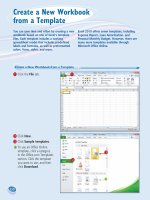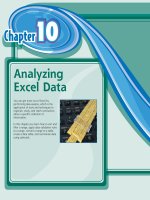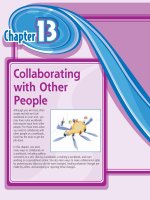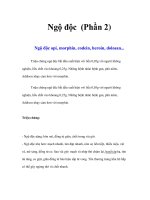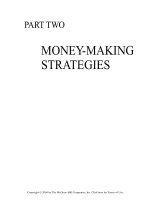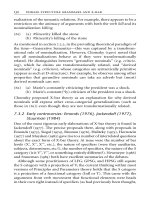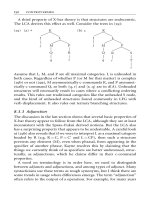Tài liệu Writing template part 2 pptx
Bạn đang xem bản rút gọn của tài liệu. Xem và tải ngay bản đầy đủ của tài liệu tại đây (1.28 MB, 10 trang )
INTRODUCTION FOR STUDENTS
WHAT ARE WRITING TEMPLATES?
Most simply stated, templates are models. More specifically, writing
templates are skeletal syntactic frameworks—parts of sentences or para-
graphs with blanks to fill in with words of your choice. They are valuable
because they help the reader understand better what you are saying.
They help you, the writer, with organization, and they help you to
develop the kinds of sentence, paragraph, and paper structure that strong
writers display. They are also a guaranteed tool for getting better scores
or grades on standardized writing tests or on class papers. Why do I say
"guaranteed"? Because the syntax (the way words are put together in
phrases and sentences) is error-free and the diction is at a high level, so
the inclusion of the template will improve the way that your writing is
received, the impression that will be left with your reader.
• WHY DO YOU NEED TEMPLATES?
Templates are needed because most writing teachers and textbooks
simply give you advice on how to write. They don't show you exactly how
to do it. Let's say you are someone who has never played golf and has
never seen golf played. You could read a book about how to hit a golf
ball, but when you actually tried to do it, you would have a very diffi-
cult time. Now what if a teacher not only let you see someone hit a golf
ball, but also put his or her arms around yours and guided you through
the correct motions? This is exactly the kind of hands-on support that
templates can provide.
When you have read and written thousands of papers, you develop
these templates. But this process takes a very long time. Using writing
templates is a shortcut to that proficiency, a shortcut helpful if you are
a non-native speaker of English or if you have not already mastered writ-
ing. After using templates a number of times, the syntax will implant
itself automatically in your head, and eventually it will become second
nature to use these syntactic frameworks.
2 Introduction for Students
• WHAT ABOUT STANDARDIZED TESTS LIKE THE SAT®
AND
THE TOEFL®?
Templates impose a structure, so your writing is better organized. In
addition, the grammar and vocabulary in the templates automatically
elevate the level of your writing. As a result, most student writers benefit
from going into the SAT® or TOEFL® armed with a few templates.
While we know that graders and raters of these tests use specific
criteria when evaluating, we also know that they read very quickly and
develop a holistic impression of a piece of writing—an impression that
is significant when assigning a score. We also know that vocabulary and
diction are a large part of what goes into the forming of that holistic
impression, which is all the more reason to use templates. In fact, some
graders report confidentially that they read only the introduction and
conclusion, and they may be very impressed by the implicit organiza-
tion of the introduction, as well as by the template conclusion. Many
writing teachers might agree that they do the same thing when reading
essays—that they don't need to read the whole paper to know student
level or evaluate the writing. As a result, you should go into the SAT* hav-
ing memorized a thesis sentence template, an introduction/roadmap
template, and a conclusion template. For the TOEFL
8
, you should also
have a summary template. The work you put into memorizing these will
pay off. Don't panic if you can't remember the templates completely;
using only part of
a
template will be of significant value. Before you start
writing your essay or even read the question, write your templates either
on a computer screen or on one of the pieces of scrap paper given to you.
Then read the question and begin your writing.
An LA Times editorial writer and test-grader offers this advice:
"Prepare a few highly burnished words that can be applied to almost
any situation. A prepared sentence or two wouldn't hurt. One essay
struck me with its well-wrought line: 'It may be the case, then, that
secrecy has its own time and place in our vast world.' I was dazzled by
the calm maturity of that sentence until I realized it could well have
been composed in advance. No matter. I gave the kid credit for plan-
ning" (Klein, "How I Gamed the SAT*," 3 April 2005).
Before we close, a word of caution is in order. With templates, as
with clothes, one size does not fit all. That is—you can't just plug your
topic into the right place and expect the template to work perfectly. The
template is not an intelligent computer. At times you need to change the
syntax or the word form (e.g., make an adjective a noun). Usually, this
Introduction for Student
is pretty obvious and easy to do. However, errors will be made. But even
with an error in the syntax, your essay will be superior to what it would
have been without using the template.
In conclusion, writing templates will help bridge the gap between you
and the advanced writer. They can make you a more confident and better
writer, which will serve you well in your work beyond tests and courses.
^ How Do THE TEMPLATE OPTIONS WORK?
When there are columns of options, any word in one column can go
with any option in another column.
are the breakfast food.
Croissants most delicious
Eggs best
Donuts healthiest
For
instance,
in this template there are nine different combinations that can
be used. Croissants may be used not only with most delicious. You have three
options with
croissants,
as
you do with donuts and with
eggs.
You could write:
Croissants are the most delicious breakfast food.
or
Croissants are the best breakfast food.
or
Croissants are the healthiest breakfast food.
Similarly, you could write:
Eggs are the most delicious breakfast food.
or
Eggs are the best breakfast food.
or
Eggs are the healthiest breakfast food.
Or:
Donuts are the most delicious breakfast food.
or
Donuts are the best breakfast food.
or
Donuts are the healthiest breakfast food.
INTRODUCTION FOR TEACHERS
What a pleasant surprise to find that one is not alone. Prior to the
national TESOL convention in 2005, I had thought that using writing
templates was my own idiosyncratic response to my students' inability
to use the instruction and correction they had been given to produce
reasonable papers. By template I mean a skeletal syntactic framework
that can be used to craft a roadmap/introduction, a conclusion, a sum-
mary, or the body of an analytic paper. In giving that TESOL presenta-
tion, I discovered that many teachers use and teach rudimentary
templates. The after-session conversation became a kind of support
group, among a dozen or so of us "closet-templatists" who had finally
found one another. I left with an e-mail list two pages long of teachers
hungry for more information on templates. Quite simply, they had seen
that, despite all the instructions they gave students on how to write a
conclusion or an introduction, the results almost never approached
what they were after and what students needed to produce in their
academic work. Many teachers turned to inventing their own templates,
although they seldom called them that. I am happy to report that writ-
ing templates are now out of the closet, perhaps for good.
GENERAL REMARKS
Few are born with the swing of Tiger Woods or Charlie Sifford, the first
African American to "make it big" on the PGA tour. Sifford relates that
as a teenager he picked up some clubs and within a week was shooting
in the 70s. Sifford's golfing ability is clearly expressing one of Howard
Gardner's multiple intelligences, and the ability to write could be
another. While these abilities in some practitioners appear to be innate,
the analogy of writing to golf is appropriate when we focus on the
nature of the writing as science. One salient feature of the scientific
process is replicability, a feature that figures significantly in templates.
One key to good golf
is
a reliable, replicable swing; one key to good writing is
reliable, replicable syntax.
On the Internet, one can obtain templates for letters of recommen-
dation, refunds, reprimands, resignations, invitations, and a host of other
rhetorical occasions. What does the marketplace tell us about the direc-
tion of our writing instruction in high school and college? One response
4
Introduction for Teache
is that templates are available for the kind of writing most people do in
the real world—that
is,
past high school or college. At one time, one might
have argued that these functions (recommendations, etc.) were part of
what we should be training our students to perform. But in the Internet
age,
that argument is no longer robust. Students can easily find unimag-
inative, simplistic templates for these functions themselves. Another
response might be that our writing instruction should be directed toward
areas that templates do not address, primarily areas that involve thought,
analysis, and argumentation. It is precisely these areas that I want to
address, with templates in mind, to explore how our methods of writing
instruction might profit from cross-fertilization via templates.
We already teach vocabulary, transitions, outlines, and even structure
by means of a five-paragraph essay (whether you agree that the five-
paragraph structure is valuable is irrelevant here). That structure is,
arguably, a kind of template. What we have largely ignored or under-
emphasized is help with the syntax necessary to create those larger
structures. In effect, we say, "Here are the bricks (vocabulary), the mortar
(transitions), and the scaffolding (essay structure), now you put it
together." Every architect learns reticulation (setting square stones on
edge diagonally) from a master, a mentor, but writing students are left
to their own devices to discover what the verbal equivalent of reticula-
tion is. What I suggest is that we show students what this syntax consists
of via templates that are general enough to be used in virtually any struc-
tured essay, which differentiates them from the templates for specific
functions (recommendations, etc.) that have been mentioned.
While writing templates are of great value to students on stan-
dardized tests, they also have instructional benefits within the standard
writing curriculum. First, they teach organization in a hands-on way.
When students actually experience an imposed structure and practice
using it, it tends to rub off. Further, noun clauses, inverted subject/verb
order, subjunctives, and other difficult structures are scaffolded so
that students can use them correctly. Idiomatic expressions that good
writers use and that few non-native speakers of English and emerging
native writers would ever use become a standard part of their writing
repertoire.
My own complete conversion to templates occurred when I found
myself lecturing for the n* time about stressing the limitations of one's
work in a conclusion. Whereas the texts I had been using primarily taught
that conclusions restate the main points, I had asked students to see their
work as part of an intellectual continuum, where they were writing in the
present, cited the past, and then in conclusion pointed to directions that
6 Introduction for Teachers
further work could go, since they had not said all that could be said
about any particular topic.
David Posner, writing in Profession (2005), concurs with this
approach: "If we are able to conclude that while we may have learned
something there is still more to be learned, we may mitigate some of the
evil inherent in the idea of a conclusion and along the way do some
good for both our readers and ourselves."
1
While the majority of my students bought into the concept of
stressing limitations in a conclusion, I very seldom saw the principle
applied in their papers. It is clear to me that, if one wants results, it
makes no more sense simply to talk about a concept, even with an
example, than it does for Tiger Woods to tell a neophyte golfer how to
swing, even with a demonstration. The neophyte golfer needs to get to
the practice range with a club in hand and with the golf template:
Position your feet with respect to the ball here.
Keep your left arm stiff here.
Throw your hips into the ball here.
Similarly, when I provided a template for the conclusion I had
been advocating, almost all of my students used versions of
it,
and their
conclusions were orders of magnitude better. An additional benefit of
conclusion templates is that they teach something about tone as well as
structure. The tone of these conclusion templates is humility, as
opposed to the self-congratulation teachers more normally see.
• ART, CRAFT, OR SCIENCE?
Writing is often referred to as an art or as a craft. I want to stress the
scientific aspect of writing, which means, simply, syntax. Putting words
together is like putting bricks atop others. They go in patterns. The
process is mostly mechanical and rarely artistic.
'David Posner, "Rhetonic, Redemption, and Fraud: What We Do When We End Books,"
Profession, no. 1 (2005), 180.
I
Introduction for Teachet
This claim does not come without some version of an Augustinian
confession. I have felt at times like a philistine, an apostate, abandoning
the "intern model" of teaching writing. What I mean by that is the typi-
cal long-term process of writing as an internship in the physician-
apprentice sense—long hours and little sleep, along with the sense that,
although the process was seriously flawed, unnecessarily harsh, and bur-
densome, the interns did it, emerging scathed but knowledgeable. Why
shouldn't the new crop of interns be similarly brutalized?
In my
view,
it is unfortunately rare that the effort is made by students
to dissect the syntactic structure of an argumentative or analytical essay. It
is as if we expect students to intuit this structure magically or, in the
humanities version of medical residency, expect our writer-interns to go
through the same lengthy apprenticeship we did and to emerge as equally
capable writers. But on the whole, this is a fantasy and does a gross dis-
service to the majority of student-writers who show the same disincli-
nation toward writing that many of us with strong verbal intelligence
have often felt toward math. We feel free to rail at how poorly math is
taught but are similarly uncritical of the tedious and antiquated
methodology often employed in teaching writing, the results of which
are unsatisfactory to a growing number of writing teachers.
Caveat: Students need to note that one size does not fit all. They can't
just plug a topic in the right place and expect the template to always work.
Some syntax needs manipulation. Usually, this is easy. Will errors be
made? Sure. But such syntax errors would probably be consistent with
similar usage errors in the student's paper, and the resulting essay will still
be superior to what would have been written without the template. Tem-
plates are no panacea. We still have to do our job. No matter what we
teach students—citation, organization, or support for an argument—they
will make mistakes from which they will learn. Templates are no different
in this regard. And templates will be internalized; they will teach.
Some colleagues are worried that if template use becomes wide-
spread, all papers will look alike. The cynic's response is that too many
are already alike, in their incompetence. My answer is that while some,
or even many, papers may bear syntactical resemblance in certain parts,
for the most part, the papers will be better than what we are seeing now.
Similarity wins, hands down, over incompetence. Good students will
eventually develop their own templates. For them, however, the process
of intuiting the syntax of an introduction/roadmap or a conclusion will
be accelerated. We are training our students for the real world, where
clarity and content are what count. No one ever complained that the
8 Introduction for Teachers
scaffolding for all of Louis Kahn's buildings looked the same. The scaf-
folding comes off and you get the architecture; the syntax comes off in
the readers' heads and they get the ideas.
Other colleagues have raised the question of plagiarism in tem-
plates. This is a non-starter. Plagiarism is most fundamentally the theft
of ideas. There are no ideas here; there is only syntax, which in most
cases is just parts of sentences. Templates are patterns, and no one owns
a pattern that has been used millions of
times.
Even the rare short com-
plete sentences in these templates have been used in their entirety tens,
if not hundreds, of thousands of
times.
They are mainly transition sen-
tences, acting like one-word transitions. Further, every template in this
book came from another source. I didn't make them up. So no teacher
can say, "That phrase, linked to that phrase, minus a few original words
in between, further linked to that phrase came from Kevin King's book,"
for that author got the phrases from someone else. They are not mine,
and they are not anybody else's. They belong to the English language.
They are the linguistic commons, and everyone has a right to them.
Moreover, numerous writing texts use rudimentary templates. Ready to
Write More, a textbook by Karen Blanchard and Christine Root,
2
gives
the following templates for topic sentences and thesis sentences:
|causes of
There are several
|
reasons for
| effects of
One writing teacher at my former school advised using the following
template in her written instructions for an essay: "A good model for the
last sentences of your first paragraph would be:
This advertisement seems to be about but is really
about . I will argue that ."
Obviously, these texts and teachers are not teaching anyone to
plagiarize. The writing templates in this book are different from these
examples only in that they are designed for specific parts of any essay
students may write; they are much more comprehensive and more
expansive, and they use more sophisticated language and structures.
2
Karen Blanchard and Christine Root, Ready to Write More: From Paragraph to Essay
(Upper Saddle River, NJ: Pearson, 2004).
Introduction for Teach
• TEMPLATES AND STANDARDIZED WRITING TESTS
(SAT®,
TOEFL®)
While the goal of writing templates is not simply to enhance scores on
standardized tests, templates are very effective tools for such tests. I
believe that students armed with templates will outperform a similar
group of students without templates for a couple of reasons. First,
organization is, while not assured, at least significantly enhanced by a
roadmap template. At whatever point in the writing process students
create a roadmap, referral to that segment will help the students to
ascertain whether or not they have followed their plan. Second, graders
of such tests, who are being paid a sum for each graded essay, generally
allow themselves about three minutes to evaluate the writing. Some
graders will look only at the introduction and the conclusion, the two
areas where templates can be most useful. The writing there will be better
and more impressive than in similar sections in the exams of students
who do not have templates. While there is, as yet, no empirical evidence
to support this claim, disbelievers would be hard-pressed to come up
with more compelling reasons for the theoretical template-less group
equaling or surpassing the performance of the template-armed group.
Caveat: Going into a standardized test situation, students may forget
some or even much of the template they had hoped to use, but some skele-
ton of it will probably remain, so that a student may recall something like:
What I've argued here is . . . and Only furter studies will show Just
remembering a few components will result in students performing
better than they would have without the template.
^ CONCLUDING REMARKS
I hope that writing teachers will expand the repertoire of their instruc-
tion by assigning essays for syntactical analysis, allowing students of all
proficiency levels to discover on their own the syntactical structures of
good essays. With that our story comes full circle, for those students will
arrive at structures similar to the ones I have presented.
Only longitudinal study will prove or disprove what I think is the
case—that students who use templates for various parts of their papers will
eventually lose their need for templates, and that the various syntactic
structures that comprise many good conclusions, introductions, etc., will
be imprinted in the heads of the students who used templates to a much
greater degree than in the heads of the students who never used them.
THESIS
SENTENCE TEMPLATES
A thesis sentence is a sentence in the introduction that tells the reader
what the topic or argument of the essay is. Experienced writers have lit-
tle difficulty writing thesis sentences. This is because they have read and
written thousands of them.
You, the emerging writer, don't have it so easy. So, you have to
accelerate the process. You do this via thesis sentence templates. A
thesis sentence template is the basic machinery of a thesis sentence,
what makes it work. It is like a car minus the hood, the doors, the en-
gine,
the side panels, the wheels, and the air conditioner. On that basic
structure, thousands of different cars can be built. From a thesis sen-
tence template, thousands of thesis sentences can be constructed.
The introduction for any piece of writing is very important. This is
where you establish a relationship with the reader. The introduction will
always be read, while the body of the paper might sometimes be glossed
over (not carefully read) by graders of standardized tests like the SAT
9
or
TOEFL*.
• How THE THESIS SENTENCE TEMPLATES WORK
Each type of thesis sentence presented in this section is followed by two
or three examples of how very different thesis sentences can be written us-
ing the template. Then you will write two or three thesis sentences of your
own using the template. If you find the template difficult, just do one sen-
tence on your own. But the more you practice, the better you will be at
writing templates. Note that when suggestions for filling in the blanks are
supplied, the small list represents just a fraction of the thousands of pos-
sible words you could use, as long it's the same part of speech.
By the time you finish writing your versions of all of the template sen-
tences, the syntactic models that native speakers have in their heads will be
more firmly implanted in your head. Any time you write an essay, review
the templates. Keep a favorite in mind, one that you can use whenever you
need it, especially when writing under the pressure of time constraints.
You are not expected to be able to use all of the thesis sentence
templates successfully. The idea is for you to find a few that you can use
and reuse with confidence. In preparation for a writing test, memorize a
couple of them, and use the one that seems to fit the topic best.



